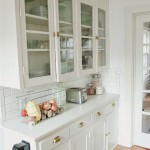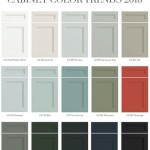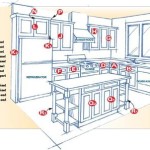```html
Annie Sloan Paint: A Comprehensive Guide for Transforming Kitchen Units
Annie Sloan Chalk Paint has gained significant popularity as a versatile medium for furniture transformation, particularly for kitchen units. Its adhesive properties, ease of use, and the aesthetically pleasing matte finish it provides make it a favored choice for both amateur and experienced DIY enthusiasts. Understanding the nuances of using Annie Sloan paint on kitchen units is essential for achieving a durable, professional-looking result.
This article provides a detailed guide to using Annie Sloan paint for kitchen unit renovation, addressing preparation, application techniques, sealing, and long-term maintenance. It aims to equip readers with the knowledge necessary to undertake a successful kitchen unit painting project.
Surface Preparation: The Foundation for a Lasting Finish
Proper surface preparation is paramount for the adhesion and longevity of any paint finish, and Annie Sloan Chalk Paint is no exception. While the paint is known for its ability to adhere to many surfaces with minimal pre-treatment, neglecting proper preparation can lead to chipping, peeling, or an uneven final result.
Cleaning: Begin by thoroughly cleaning the kitchen units. Remove all hardware, such as knobs, handles, and hinges. Use a degreasing cleaner to eliminate grease, grime, and food residue. Sugar soap is a commonly recommended option for this purpose. Rinse thoroughly with clean water and allow the units to dry completely.
Assessing the Existing Finish: Evaluate the existing finish on the kitchen units. If the units have a glossy or particularly slick surface, a light sanding may be necessary to create a "key" for the paint to grip onto. This involves using a fine-grit sandpaper (around 220 grit) to gently roughen the surface. Focus on areas that may experience heavy use or friction.
Repairing Damage: Address any damage to the units, such as chips, dents, or scratches. Fill these imperfections with a wood filler, allowing it to dry completely according to the manufacturer's instructions. Sand the filled areas smooth, ensuring they are flush with the surrounding surface. Remove all sanding dust with a tack cloth.
Priming (Optional): While Annie Sloan Chalk Paint often eliminates the need for priming, it may be beneficial in certain situations. If the existing finish is stained or has a strong color that could bleed through the new paint, a stain-blocking primer can prevent this. Also, if painting over raw wood or a very porous surface, a primer can help to seal the surface and ensure even paint absorption.
Masking: Use painter's tape to mask off any areas that should not be painted, such as walls, countertops, or the interior of cabinets. This ensures clean, crisp lines and protects adjacent surfaces.
Application Techniques: Achieving the Desired Aesthetic
The application of Annie Sloan Chalk Paint offers a range of aesthetic possibilities, from a smooth, contemporary finish to a textured, distressed look. The choice of application technique depends on the desired outcome.
Paint Consistency: Annie Sloan Chalk Paint is naturally thick. Depending on the desired finish and the application method, it may be necessary to dilute the paint slightly with water. For a smoother finish, add a small amount of water to the paint and stir thoroughly. For a more textured finish, use the paint straight from the can.
Brush Application: A good quality brush is essential for achieving a professional finish. Annie Sloan specifically offers brushes designed for use with her paint, but other natural or synthetic bristle brushes can also be used. Apply the paint in thin, even coats, working in the direction of the wood grain. Avoid applying too much paint at once, as this can lead to drips and uneven drying. Apply two to three coats of paint, allowing each coat to dry completely before applying the next. Drying time will vary depending on the humidity and temperature.
Roller Application: For larger, flatter surfaces, a foam roller can be used to apply the paint. This can help to create a smoother, less textured finish. Use a high-density foam roller and apply the paint in thin, even coats. Be careful not to apply too much pressure, as this can create roller marks. As with brush application, apply two to three coats of paint, allowing each coat to dry completely before applying the next.
Distressing Techniques: One of the hallmarks of Annie Sloan paint is its suitability for distressing. This involves removing some of the paint to reveal the underlying surface, creating a worn, aged look. Distressing can be achieved using various methods, including sanding with sandpaper (usually medium to fine grit), using a damp cloth to wipe away paint before it dries completely, or using a distressing tool. The amount of distressing is a matter of personal preference.
Color Blending and Layering: Annie Sloan paint allows for color blending and layering. Multiple colors can be applied and blended together to create unique effects. This can be achieved by applying different colors in layers, allowing each layer to dry partially before applying the next, or by blending colors together on the surface while they are still wet. Experimentation is encouraged to achieve the desired effect.
Dry Brushing: Dry brushing involves using a brush with very little paint on it to create a textured, streaky effect. Dip the tips of the brush bristles into the paint, then wipe off most of the paint onto a paper towel. Lightly drag the brush across the surface, following the grain of the wood. This technique works well for highlighting details and creating a rustic look.
Sealing and Protection: Ensuring Durability and Longevity
Once the paint has dried completely, it is essential to seal the surface to protect it from wear and tear, water damage, and stains. Sealing is crucial for kitchen units, which are subject to frequent use and exposure to moisture and food spills.
Annie Sloan Wax: Annie Sloan wax is a popular choice for sealing her Chalk Paint. It is a soft, pliable wax that is easy to apply and provides a durable, matte finish. Apply the wax using a wax brush or lint-free cloth, working it into the paint in a circular motion. Remove any excess wax with a clean cloth. Allow the wax to cure for at least 24 hours before using the kitchen units. The wax can be buffed to increase the sheen, although it will remain primarily matte.
Annie Sloan Lacquer: For a more durable and water-resistant finish, Annie Sloan lacquer is an alternative to wax. The lacquer is a water-based varnish that provides a matte or gloss finish. Apply the lacquer with a brush or roller, following the manufacturer's instructions. Apply two to three coats, allowing each coat to dry completely before applying the next. Lacquer provides a harder, more protective finish than wax, making it a good choice for high-traffic areas or surfaces that are frequently exposed to water.
Alternatives to Annie Sloan Sealing Products: While Annie Sloan wax and lacquer are designed specifically for use with her Chalk Paint, other sealing products can also be used. Water-based polyurethanes are a common alternative, offering durability and water resistance. Choose a matte or satin finish polyurethane to maintain the Chalk Paint's characteristic matte appearance. Always test the sealing product in an inconspicuous area before applying it to the entire surface to ensure compatibility and desired finish.
Multiple Coats: Regardless of the chosen sealant, applying multiple thin coats is preferable to applying one thick coat. This ensures even coverage and a stronger, more durable finish. Allow each coat to dry completely before applying the next.
Maintenance: Once the kitchen units have been painted and sealed, regular maintenance is necessary to keep them looking their best. Clean the units with a mild soap and water solution. Avoid using harsh chemicals or abrasive cleaners, as these can damage the paint and sealant. Reapply wax or lacquer as needed to maintain the protective finish.
The successful transformation of kitchen units with Annie Sloan Chalk Paint hinges on meticulous preparation, thoughtful application, and appropriate sealing. By adhering to these guidelines, individuals can achieve a durable, aesthetically pleasing, and personalized kitchen space.
```
Step By Kitchen Cabinet Painting With Annie Sloan Chalk Paint Jeanne Oliver

Step By Kitchen Cabinet Painting With Annie Sloan Chalk Paint Jeanne Oliver

Step By Kitchen Cabinet Painting With Annie Sloan Chalk Paint Jeanne Oliver

Annie Sloan Chalk Paint Kitchen Cabinets A Créé Une Peintu Painting

Kitchen Annie Sloan Chalk Paint In French Linen I Did On My Top Cabinets And Painted Grey Inspirations Home Kitchens

Chalk Painted Kitchen Cabinets 2 Years Later Our Storied Home

Chalk Painted Kitchen Cabinets 2 Years Later Our Storied Home

Step By Kitchen Cabinet Painting With Annie Sloan Chalk Paint Jeanne Oliver

Painted Cabinets A Review Of Our With Annie Sloan Chalk Paint Md Haney Co At Westerlook Farm

Why I Repainted My Chalk Painted Cabinets Sincerely Sara D Home Decor Diy Projects
Related Posts








